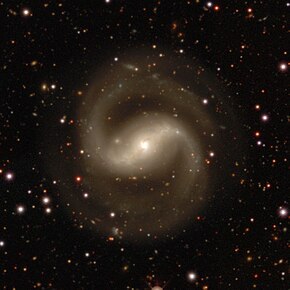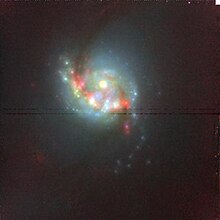| NGC 5135 | |
|---|---|
 NGC 5135 by legacy surveys NGC 5135 by legacy surveys | |
| Observation data (J2000 epoch) | |
| Constellation | Hydra |
| Right ascension | 13 25 44.1 |
| Declination | −29° 50′ 01″ |
| Redshift | 0.013693 ± 0.000020 |
| Heliocentric radial velocity | 4,105 ± 6 km/s |
| Distance | 194 Mly |
| Apparent magnitude (V) | 12.9 |
| Characteristics | |
| Type | SB(l)ab |
| Apparent size (V) | 2.6′ × 1.8′ |
| Notable features | Seyfert galaxy |
| Other designations | |
| ESO 444-G032, MCG -05-32-013, PGC 46974 | |
NGC 5135 is a barred spiral galaxy located in the constellation Hydra. It is located at a distance of about 200 million light years from Earth. It was discovered by John Herschel on May 8, 1834. It is a Seyfert galaxy.
Characteristics
NGC 5135 has well defined spiral arms and is considered a grand design spiral galaxy. There is star formation along the leading edges of the arms. There are dust lanes along the bar that curve towards the centre of galaxy. Spiral arms become less well structured in the central regions.

NGC 5135 is a bright source in infrared light and with total infrared luminosity of 10−10 L☉ is considered a luminous infrared galaxy. Also strong ultraviolet emission was detected in the central 2 arcseconds of the galaxy, with a dozen of prominent knots, indicative of a recent starburst. The total star formation rate in the galaxy is estimated to be 15.61 ± 1.87 M☉ per year. Knots of gas measuring 45–180 parsecs across are detected along the inner spiral arms in CO(6-5) imaging and some of them are associated with starburst regions.
The nucleus of NGC 5135 has been found to be active and it has been categorised as a type II Seyfert galaxy. The most accepted theory for the energy source of active galactic nuclei is the presence of an accretion disk around a supermassive black hole. The mass of the black hole in the centre of NGC 5135 is estimated to be 10 (19 million) M☉.
The active nucleus is obscured in X-rays by Compton-thick material with a column density of 6.7+16.6
−2.8×10/cm. An ionization cone has been detected in emission that extends for 600 parsec from the nucleus. To the ionization of the gas apart from the active nucleus also contribute supernova remnant shocks and young stars.
One supernova has been observed in NGC 5135: SN 2023dpj (type II, mag. 17).
Nearby galaxies
NGC 5135 belongs to a galaxy group known as LGG 351 or NGC 5135 group. Other members of the group include ESO 444- 12, NGC 5124, IC 4248, NGC 5150, NGC 5152, NGC 5153, IC 4275, NGC 5182, ESO 444- 47, ESO 444- 15, ESO 444- 21 and IC 4251, along with NGC 5126. IC 4248, which lies 13.5 arcminutes from NGC 5135 and form a pair, looks distorted and asymmetrical.
See also
References
- ^ "NASA/IPAC Extragalactic Database". Results for NGC 5135. Retrieved 2023-05-06.
- Seligman, Courtney. "NGC 5135". Celestial Atlas. Retrieved 19 November 2018.
- ^ Martini, Paul; Regan, Michael W.; Mulchaey, John S.; Pogge, Richard W. (June 2003). "Circumnuclear Dust in Nearby Active and Inactive Galaxies. I. Data". The Astrophysical Journal Supplement Series. 146 (2): 353–406. arXiv:astro-ph/0212396. Bibcode:2003ApJS..146..353M. doi:10.1086/367817.
- Sandage, A., Bedke, J. (1994), The Carnegie Atlas of Galaxies. Volume I, Carnegie Institution of Washington
- Sanders, D. B.; Mazzarella, J. M.; Kim, D.-C.; Surace, J. A.; Soifer, B. T. (October 2003). "The IRAS Revised Bright Galaxy Sample". The Astronomical Journal. 126 (4): 1607–1664. arXiv:astro-ph/0306263. Bibcode:2003AJ....126.1607S. doi:10.1086/376841. S2CID 14825701.
- ^ Gruppioni, C.; Berta, S.; Spinoglio, L.; Pereira-Santaella, M.; Pozzi, F.; Andreani, P.; Bonato, M.; De Zotti, G.; Malkan, M.; Negrello, M.; Vallini, L.; Vignali, C. (1 June 2016). "Tracing black hole accretion with SED decomposition and IR lines: from local galaxies to the high- z Universe". Monthly Notices of the Royal Astronomical Society. 458 (4): 4297–4320. arXiv:1603.02818. Bibcode:2016MNRAS.458.4297G. doi:10.1093/mnras/stw577.
- Gonzalez Delgado, Rosa M.; Heckman, Timothy; Leitherer, Claus; Meurer, Gerhardt; Krolik, Julian; Wilson, Andrew S.; Kinney, Anne; Koratkar, Anuradha (20 September 1998). "Ultraviolet-Optical Observations of the Seyfert 2 Galaxies NGC 7130, NGC 5135, and IC 3639: Implications for the Starburst–Active Galactic Nucleus Connection". The Astrophysical Journal. 505 (1): 174–198. arXiv:astro-ph/9806107. Bibcode:1998ApJ...505..174G. doi:10.1086/306154. S2CID 119098033.
- Cao, Tianwen; Lu, Nanyao; Xu, C. Kevin; Zhao, Yinghe; Kalari, Venu Madhav; Gao, Yu; Charmandaris, Vassilis; Santos, Tanio Diaz; Werf, Paul van der; Cao, Chen; Wu, Hong; Inami, Hanae; Evans, Aaron (18 October 2018). "ALMA Observation of NGC 5135: The Circumnuclear CO (6–5) and Dust Continuum Emission at 45 pc Resolution". The Astrophysical Journal. 866 (2): 117. arXiv:1809.06283. Bibcode:2018ApJ...866..117C. doi:10.3847/1538-4357/aae1f4.
- Levenson, N. A.; Weaver, K. A.; Heckman, T. M.; Awaki, H.; Terashima, Y. (10 February 2004). "Accretion and Outflow in the Active Galactic Nucleus and Starburst of NGC 5135". The Astrophysical Journal. 602 (1): 135–147. arXiv:astro-ph/0310669. Bibcode:2004ApJ...602..135L. doi:10.1086/380836. S2CID 16284435.
- Marinucci, Andrea; Bianchi, Stefano; Nicastro, Fabrizio; Matt, Giorgio; Goulding, Andy D. (1 April 2012). "The Link Between the Hidden Broad Line Region and the Accretion Rate in Seyfert 2 Galaxies". The Astrophysical Journal. 748 (2): 130. arXiv:1201.5397. Bibcode:2012ApJ...748..130M. doi:10.1088/0004-637X/748/2/130. S2CID 38183296.
- Yamada, Satoshi; Ueda, Yoshihiro; Tanimoto, Atsushi; Oda, Saeko; Imanishi, Masatoshi; Toba, Yoshiki; Ricci, Claudio (7 July 2020). "Nature of Compton-thick Active Galactic Nuclei in "Nonmerging" Luminous Infrared Galaxies UGC 2608 and NGC 5135 Revealed with Broadband X-Ray Spectroscopy". The Astrophysical Journal. 897 (1): 107. arXiv:2005.08718. Bibcode:2020ApJ...897..107Y. doi:10.3847/1538-4357/ab94b1.
- Bedregal, Alejandro G.; Colina, Luis; Alonso-Herrero, Almudena; Arribas, Santiago (20 June 2009). "Near-Ir Integral Field Spectroscopy Study of the Star Formation and Agn of the Lirg NGC 5135". The Astrophysical Journal. 698 (2): 1852–1871. arXiv:0904.3324. Bibcode:2009ApJ...698.1852B. doi:10.1088/0004-637X/698/2/1852. S2CID 15278691.
- Transient Name Server entry for SN 2023dpj. Retrieved 25 October 2023.
- Garcia, A. M. (1 July 1993). "General study of group membership. II. Determination of nearby groups". Astronomy and Astrophysics Supplement Series. 100: 47–90. Bibcode:1993A&AS..100...47G. ISSN 0365-0138.
- de Vaucouleurs, G.; de Vaucouleurs, A.; Corwin, J. R. (1 January 1976). "Second reference catalogue of bright galaxies". Second Reference Catalogue of Bright Galaxies. 1976. Bibcode:1976RC2...C......0D.
- For, B-Q; Staveley-Smith, L; Westmeier, T; Whiting, M; Oh, S-H; Koribalski, B; Wang, J; Wong, O I; Bekiaris, G; Cortese, L; Elagali, A; Kleiner, D; Lee-Waddell, K; Madrid, J P; Popping, A; Rhee, J; Reynolds, T N; Collier, J D; Phillips, C J; Voronkov, M A; Müller, O; Jerjen, H (11 November 2019). "WALLABY early science − V. ASKAP H i imaging of the Lyon Group of Galaxies 351". Monthly Notices of the Royal Astronomical Society. 489 (4): 5723–5741. doi:10.1093/mnras/stz2501. hdl:1885/266365.
External links
- NGC 5135 on WikiSky: DSS2, SDSS, GALEX, IRAS, Hydrogen α, X-Ray, Astrophoto, Sky Map, Articles and images
- NGC 5135 on SIMBAD
| Constellation of Hydra | |||||||||||||||
|---|---|---|---|---|---|---|---|---|---|---|---|---|---|---|---|
| Stars |
| ||||||||||||||
| Star clusters |
| ||||||||||||||
| Nebulae |
| ||||||||||||||
| Galaxies |
| ||||||||||||||
| Galaxy clusters |
| ||||||||||||||
| Astronomical events | |||||||||||||||